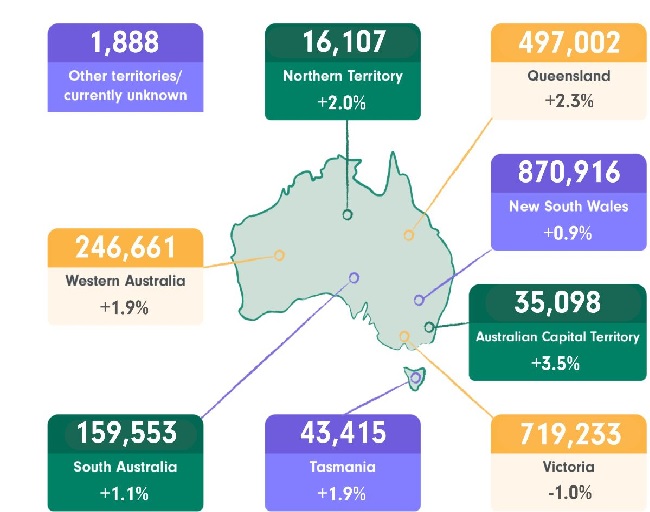A successful business starts from a great idea and then puts that idea to life. Whether you are a small startup or an established enterprise, the path to success involves much more than selling a product or providing a service.
Australian businesses have faced a tough climate over the past few years, with the 2022/23 financial year proving particularly challenging. New data highlights a sharp decline in new business startups and a notable rise in closures compared to the previous financial year (2021/22).
According to the figures, there were 2,589,873 actively trading businesses in Australia as of 30 June 2023. To put that into perspective, this means there is nearly one business for every 10 Australians.
While there was a slight 0.8% increase in the total number of businesses in FY 2022/23—equating to 19,973 additional businesses—this marks a sharp slowdown compared to the previous year’s growth of 7% (167,646 new businesses).
The survival rate of new businesses
Business survival rates across industries also paint a mixed picture. Sectors like agriculture, forestry, and fishing had a three-year survival rate of just under 64% for businesses started in the 2018/19 financial year.
On the flip side, the transport, postal, and warehousing sectors saw only 35.6% of businesses make it past the same time frame.
Overall, the survival rate across all industries stood at 50.8%, showing the tough conditions that Australian businesses must navigate to stay afloat in an increasingly competitive and uncertain environment.
State-by-state business statistics

The Australian Capital Territory saw the highest percentage growth in business operations during 2022-23, with a 3.5% increase, more than three times New South Wales’ growth rate of 1.1%. Despite this, NSW remains the state with the largest number of businesses, totaling 870,916.
Victoria was the only state to experience a decline in the number of businesses, with 7,607 fewer operating than the previous year, marking a 1% drop. It also had the highest number of businesses relocating to other states (-1,345), while Queensland attracted the most, with an increase of 1,782 businesses.
In terms of businesses per capita, New South Wales leads with 0.11 businesses per person, while Tasmania has the lowest at 0.06.
The Northern Territory reported the lowest business survival rate, with only 48.2% of businesses lasting beyond three years, whereas Tasmania boasted the highest survival rate at 54.7%.
Building a Strong Brand Identity
Before winning over customers, you need to establish a brand identity. Your brand is the personality of your business as it tells customers who you are, what you do, and why you are different from the others. However, a strong brand goes beyond just having a catchy name or logo as it is about consistency.
According to “Snap Printing Solutions” a team of printers in Sydney and NSW, businesses need to engage in activities that reinforce their brand, and this is why their services and printing in Sydney can have an amazing impact.
“From your business cards to your packaging, printed materials are one of the first things that people will see. In this case, a high-quality printed brochure or flyer simply entails professionalism and trustworthiness,” said a company spokesperson.
What is the success rate of business cards?
While the average website conversion rate hovers around 2.35%, business cards boast an impressive 12% conversion rate. This is why 34% of e-commerce businesses now include business cards.
Connecting with Your Target Market
The success of your business is dependent on how well you understand who your customers are. You could have the best product in the world, but if you are marketing it to the wrong people, it will not become salable.
So, you have to take time to research and understand your target market, including their needs, preferences, and if they prefer online or offline.
For example, marketing is key, and while digital strategies are crucial, physical print marketing is often underestimated. Direct mail, brochures, and posters can be great techniques for reaching people who are not as engaged online or who value a more tangible form of communication. That said, printed materials can leave a long-lasting impression.
Focusing on Customer Service
You should know that customer service is one of the most important factors. Happy customers are loyal customers, and they are more likely to recommend you to others.
So, the businesses that invest time in developing good relationships with their customers, offering top-notch support, and resolving issues quickly are the ones that will eventually succeed.
Take note that even the smallest touches can make a difference here. For instance, sending out printed thank you notes or offering discount vouchers adds a personal touch.
Effective Marketing and Promotions
The market is already crowded, so it is not enough to rely on word-of-mouth to grow your business. You also need to actively market your products or services consistently. This is where both digital and traditional marketing come into play.
While online marketing tools like social media and emails are fantastic for quick, wide-reaching campaigns, do not overlook the power of good old-fashioned print advertising.
Investing in Innovation and Adaptability
Successful businesses are always on the lookout for ways to innovate and stay ahead. This means that they constantly keep an eye on market trends, new technologies, and changing customer preferences.
The most successful businesses are the ones that are not afraid to try new things and adapt to change. So, if a particular business recognises that its customers appreciate sustainable practices, switching to eco-friendly printing for packaging or promotional materials can be a smart move.
In Australia, print advertising still holds strong, with 82% of consumers trusting ads in magazines and newspapers. In stark contrast, only 25% trust online ads. The gap highlights the enduring credibility of traditional media in the increasingly digital landscape we live in 2024.







